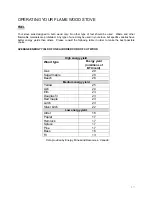
3
INTRODUCTION
THE FLAME WOOD STOVE MANUAL
Stove Builder International inc (SBI)
, one of the most important wood stove and fireplace manufacturers in
North America, congratulates you on your purchase and wishes to help you get maximum satisfaction from
the wood stove you have selected. In the pages that follow, we will give you advices on wood heating and
controlled combustion as well as technical specifications regarding installation, operation and maintenance of
the model you have chosen.
The instructions pertaining to the installation of your wood stove comply with ULC #S627 standards. You
must follow them very carefully in order to eliminate any chance of encountering major problems.
Read this entire manual before you install and use your new stove. If this stove is
not properly installed, a house fire may result. To reduce the risk of fire, follow the
installation instructions. Failure to follow instructions may result in property
damage, bodily injury or even death.
PLEASE CONSULT LOCAL AUTHORITIES, BUILDING DEPARTMENT OR FIRE
MARSHALL ABOUT RESTRICTIONS, INSTALLATION REQUIREMENTS AND FOR
THE NEED TO OBTAIN A PERMIT BEFORE YOU INSTALL YOUR WOOD STOVE
.
KEEP THIS INSTRUCTION MANUAL FOR FUTURE REFERENCE.
WOOD HEATING
Many consumers choose wood as the main or auxiliary energy source for heating their dwelling or secondary
residence. This source of energy has the advantage of being abundant, relatively cheap and easy to store
so that you are assured of energy autonomy for more of less longer periods.
THE CONTROLLED COMBUSTION WOOD STOVE
The main feature of a controlled combustion wood stove is an air tightness that is the most perfect possible,
and must of course be equipped with the most efficient heat exchanger possible in order to transfer
maximum heat to the ambient air. It is generally doubled with firebricks, and it may have a glass door, with
steel or cast iron frame. The main feature that makes it a controlled combustion wood stove remains its air
tightness, which allows the user to control the quantity of oxygen admitted into the wood stove.
The wood will burn slowly if the wood stove draught keys are adjusted in order to reduce the oxygen supply
in the combustion chamber to minimum; on the other hand, wood will burn quickly if the draught keys are
adjusted to admit a larger quantity of oxygen in the combustion chamber.




































